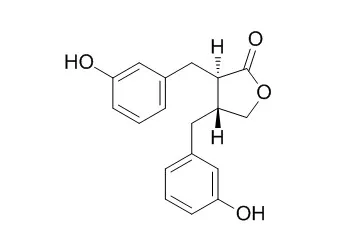| Description: |
Enterolactone( Enl ) has chemopreventive action, it suppresses colo 201 human colon cancer cell growth both in vitro and in vivo. Enl may affect the growth of these estrogen sensitive cells is by competition of Enl and its sulfate with the estrogens for sulfokinases and sulfatases involved in estrogen metabolism in the cells. Enl acts as a weak aromatase inhibitor in vitro and to reduce the relative uterine weight of the 7,12-dimethylbenz(a)anthracene-treated nonovariectomized rats. |
| Targets: |
p53 | Caspase | Bcl-2/Bax |
| In vitro: |
| Anticancer research, 2005, 25(3B):2269-2276. | | Enterolactone induces apoptosis and inhibits growth of Colo 201 human colon cancer cells both in vitro and in vivo.[Reference: WebLink] | The mammalian lignan Enterolactone (ENL) is produced from plant lignans which are present in large amounts in flaxseed (linseed). The effect of ENL on colon cancer cell growth in vitro and in vivo, and its mechanisms of action, have not been studied in detail.
METHODS AND RESULTS:
The growth of the colo 201 human colon cancer cell line was examined by colorimetric 3-(4,5-dimethylthiazol-2-yl)-5- (3-carboxymethoxyphenyl)-2- (4-sulphophenyl)-2H-tetrazolium (MTS) assay, while the expression of apoptosis- and proliferation-related proteins (p53, Bax, Bcl-xL and S, Bcl-2, Caspase-8, Caspase-3 and proliferating cell nuclear antigen (PCNA)) were examined by Western blotting. In vivo tumor growth was examined by transplanting colo 201 cells into ENL-treated and placebo-treated athymic mice. The MTS assay showed that ENL suppressed colo 201 cell growth (IC50 for 72 h: 118.4 microM) in vitro. On flow cytometry, induction of apoptosis was confirmed by the appearance of subG1 populations, while cell cycle progression was not affected. The expression of an apoptosis-suppressing protein (Bcl-2) was down-regulated, an apoptosis-enhancing protein (cleaved form of Caspase-3) was up-regulated, proliferation-related PCNA protein was down-regulated and p53, Bax, Bcl-xL and S and Caspase-8 levels were unchanged. ENL, at a dose of 10 mg/kg given 3 times per week by subcutaneous injection, significantly inhibited the growth of colo 201 cells transplanted into athymic mice without any adverse effects.
CONCLUSIONS:
ENL suppressed colo 201 human colon cancer cell growth both in vitro and in vivo. The tumor-suppressing mechanisms included apoptosis and decreased cell proliferation. |
|
| In vivo: |
| American Journal of Epidemiology,2002,155(5):472-477. | | Use of Oral Antimicrobials Decreases Serum Enterolactone Concentration.[Reference: WebLink] | The lignan Enterolactone, a phytoestrogen, may protect against hormone-dependent cancers and cardiovascular diseases. It is produced by the intestinal microflora from dietary precursors. Because of the pronounced impact of antimicrobials on the intestinal microflora, the authors examined whether serum Enterolactone concentration is affected by previous use of oral antimicrobials.
METHODS AND RESULTS:
Enterolactone was measured by time-resolved fluoroimmunoassay in 2,753 Finnish men and women aged 25–64 years who participated in a cross-sectional national survey in 1997. Background information was collected by self-administered questionnaire, and data on antimicrobial treatment were gathered from the nationwide prescription database of the Social Insurance Institution. Serum Enterolactone concentration was significantly lower in those who had used oral antimicrobials up to 12–16 months before serum sampling than in nonusers (16.4 vs. 19.3 nmol/liter). The concentration was associated with the number of treatments and the time from the last treatment. Modest differences were present between various antimicrobials.
CONCLUSIONS:
The authors' findings support the crucial role of gut microflora in the metabolism of lignans. Furthermore, recent use of antimicrobials should be considered when the association between serum Enterolactone concentration and risk of chronic diseases is studied. | | Molecular cancer therapeutics, 2002, 1(10):869-876. | | Enterolactone Inhibits the Growth of 7,12-Dimethylbenz(a) anthracene-induced Mammary Carcinomas in the Rat 1 Supported by The National Technology Agency of Finland (TEKES) through Projects 51583/00 and 40078/01. [Reference: WebLink] | The inverse association between a high Enterolactone (ENL) concentration in both urine and serum, and the risk of breast cancer found in epidemiological studies suggests a chemopreventive action for ENL. However, no causal relationship has been established in clinical studies or in experimental models for breast cancer.
METHODS AND RESULTS:
In the present study, the potential chemopreventive action of p.o. administered ENL (1 or 10 mg/kg of body weight) was tested in 7,12-dimethylbenz(a)anthracene-induced mammary cancers of the rat. Rats were maintained on a standard open-formula chow diet. Daily p.o. administration of ENL at a dose of 10 mg/kg of body weight for 7 weeks significantly inhibited tumor growth. The growth-inhibitory effect of ENL was more pronounced on the new tumors, which developed during the treatment period, but ENL also inhibited the growth of those tumors established before the start of the lignan administration. The rat serum concentration of ENL, which illustrated a permanent positive effect on breast cancer growth, was 0.4 μm, which is >10-fold as compared with the serum concentrations found in the general human population. The effect of ENL was not restricted to any specific histological tumor type. ENL was demonstrated to act as a weak aromatase inhibitor in vitro and to reduce the relative uterine weight of the 7,12-dimethylbenz(a)anthracene-treated nonovariectomized rats. However, in a short-term assay ENL had no effect on the uterine growth of the intact or androstenedione-treated immature rats.
CONCLUSIONS:
Thus, the mechanism of the ENL action and its minimum or optimal daily dose remains to be clarified. |
|






 Cell. 2018 Jan 11;172(1-2):249-261.e12. doi: 10.1016/j.cell.2017.12.019.IF=36.216(2019)
Cell. 2018 Jan 11;172(1-2):249-261.e12. doi: 10.1016/j.cell.2017.12.019.IF=36.216(2019) Cell Metab. 2020 Mar 3;31(3):534-548.e5. doi: 10.1016/j.cmet.2020.01.002.IF=22.415(2019)
Cell Metab. 2020 Mar 3;31(3):534-548.e5. doi: 10.1016/j.cmet.2020.01.002.IF=22.415(2019) Mol Cell. 2017 Nov 16;68(4):673-685.e6. doi: 10.1016/j.molcel.2017.10.022.IF=14.548(2019)
Mol Cell. 2017 Nov 16;68(4):673-685.e6. doi: 10.1016/j.molcel.2017.10.022.IF=14.548(2019)